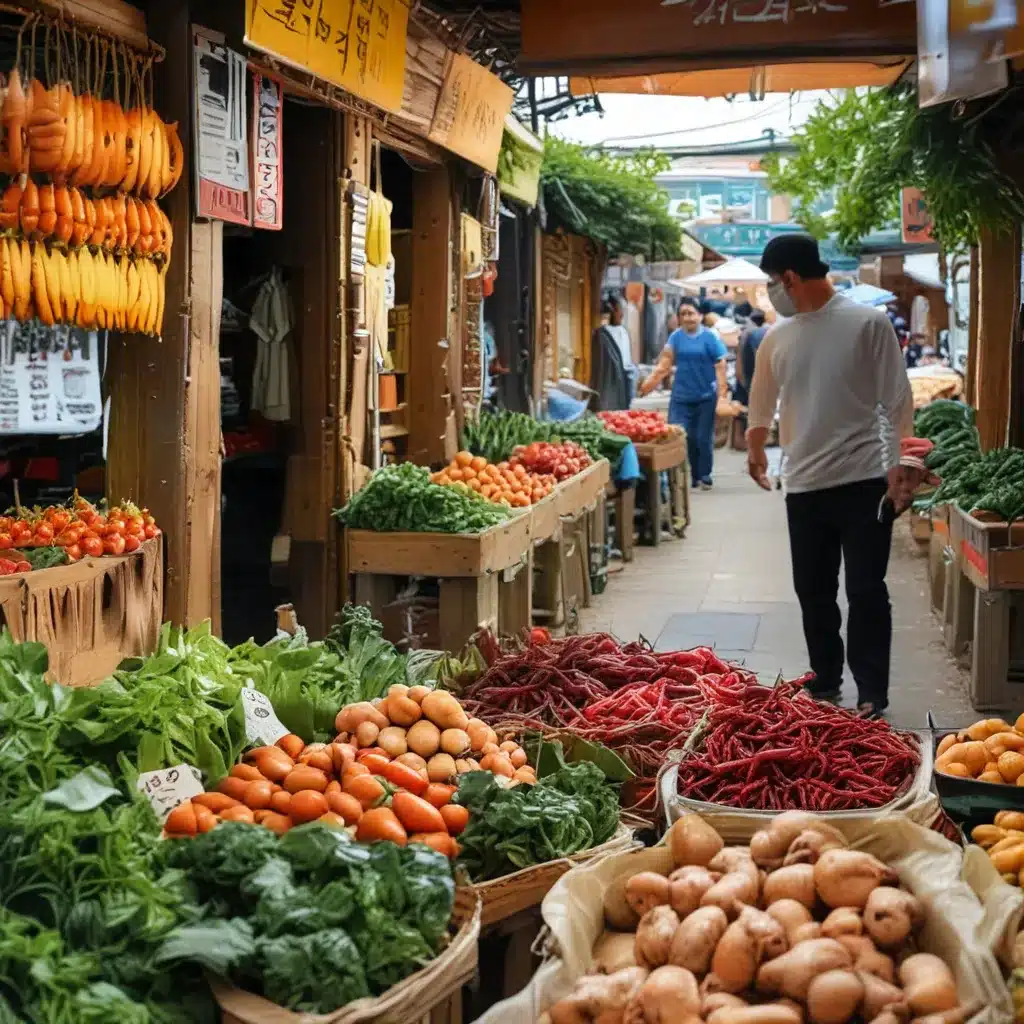
Discovering the Vibrant Heart of Seoul’s Culinary Scene
As I step through the bustling entrance of the Gwangjang Market, the chaotic symphony of sizzling pans, haggling vendors, and the chatter of eager foodies assaults my senses. This historic market, nestled in the heart of Seoul, South Korea, is renowned as a mecca for local cuisine – a veritable locavore’s paradise that has captured the imagination of travelers far and wide.
I can feel the excitement building as I navigate the maze of stalls, my eyes darting from one tantalizing display to the next. The air is thick with the aromatic allure of Korean street food – crisp bindaetteok (mung bean pancakes), glistening odeng (fish cakes), and the unmistakable scent of soju, the country’s beloved rice liquor. It’s a tantalizing sensory overload, and I can’t wait to dive in.
Unearthing the Culinary Treasures of Gwangjang Market
As I weave my way through the throngs of hungry patrons, I’m struck by the sheer diversity of offerings on display. From the iconic kimbap (Korean-style sushi rolls) to the savory tteokbokki (spicy rice cakes), the market is a veritable cornucopia of traditional Korean fare. But the real gems, I soon discover, lie in the lesser-known specialties that have been perfected over generations.
I pause at a stall serving bindaetteok, the crisp mung bean pancakes that are a staple of the market’s culinary landscape. The vendor, a weathered but jovial woman, greets me with a warm smile and a quick lesson on the art of making these delectable treats. “We’ve been serving these same recipes for over 50 years,” she tells me, her hands deftly maneuvering the sizzling batter. “Each one is made with love and a touch of tradition.”
As I bite into the perfectly crisp exterior and savor the soft, earthy interior, I’m transported to a different time and place. This is the essence of Gwangjang Market – a celebration of the time-honored techniques and ingredients that have defined Korean cuisine for centuries.
Immersing Myself in the Vibrant Community of Gwangjang Market
But the market is more than just a culinary wonderland; it’s a vibrant community that pulses with the energy of a thousand stories. I find myself drawn to the vendors, each with their own unique tale to tell. There’s the elderly couple selling handmade dumplings, their faces etched with the memories of a lifetime spent perfecting their craft. The young entrepreneur peddling artisanal kimchi, her eyes sparkling with the passion of a new generation keeping tradition alive.
As I engage with these remarkable individuals, I’m struck by the sense of camaraderie that permeates the market. It’s a place where strangers become friends, where stories are shared over plates of steaming, soul-nourishing food. I can’t help but wonder about the lives that have been woven into the fabric of this place – the triumphs and struggles, the laughter and tears, all converging in this bustling epicenter of Korean culinary heritage.
Uncovering the Layers of History at Gwangjang Market
But the Gwangjang Market is more than just a testament to the present; it’s a living, breathing connection to the past. As I delve deeper into its history, I uncover a tapestry of stories that stretch back generations, each thread a testament to the resilience and ingenuity of the Korean people.
The market’s origins can be traced back to the late 19th century, when it began as a humble gathering of street vendors peddling their wares. Over the decades, it has weathered wars, industrialization, and the relentless march of progress, yet it has managed to retain its authentic character and unwavering dedication to traditional Korean cuisine.
I find myself in awe of the market’s ability to adapt and evolve while still holding fast to its core identity. It’s a testament to the enduring spirit of the Korean people, who have fiercely protected their culinary heritage even in the face of rapid modernization.
Leaving Gwangjang Market with a Renewed Appreciation for Korean Cuisine
As I reluctantly bid farewell to the Gwangjang Market, my senses still reeling from the sensory overload, I can’t help but feel a profound sense of gratitude. This place has not only satisfied my culinary cravings but has also ignited a deeper appreciation for the rich tapestry of Korean food culture.
The flavors, the stories, the very essence of this market have left an indelible mark on my soul. I know that whenever I return to Seoul, the Gwangjang Market will beckon me back, a siren’s call to once again immerse myself in the vibrant heart of the city’s culinary scene.
And who knows, perhaps next time I’ll even muster the courage to try the mysterious and iconic Korean delicacy of sannakji – raw, wriggling octopus tentacles. After all, what’s a visit to the Gwangjang Market without a little adventure?

